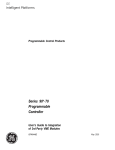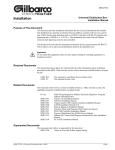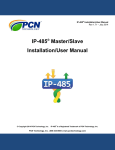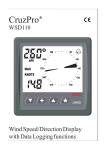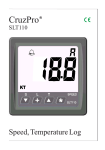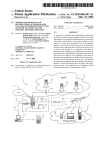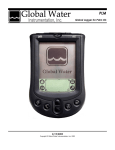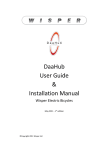Download "service manual"
Transcript
FleetLINK ® Fuel Control System Vehicle Information Unit (VIU) Installation & Service Manual ©2004 OPW Fuel Management Systems Manual No. M00-047.10 OPW Fuel Management Systems FleetLINK System and Replacement Parts Warranty Statement Effective May 1, 2004 FleetLINK System Components OPW Fuel Management Systems warrants that all components of the OPW FleetLINK System (excluding Pump, Nozzle and Vehicle components supplied by OPW Fuel Management Systems to the Original Purchaser will be free from defects in material and/or workmanship under normal use and service for a period of 12 months (90 days labor) from the date of installation. FleetLINK Pump and Nozzle Components OPW Fuel Management Systems warrants all FleetLINK Pump and Nozzle components for ONE YEAR parts, 90 DAYS labor from the date of installation. Pump and Nozzle Components include the Pump Barriers, Nozzle coils and any associated wiring. FleetLINK Vehicle Components OPW Fuel Management Systems warrants all FleetLINK Vehicle components for ONE YEAR parts ONLY from the date of installation. Vehicle Components include the Vehicle Identification Unit (VIU) and the tank coil. Replacement Parts, New and Remanufactured OPW Fuel Management Systems warrants all upgrades and replacement parts (new and remanufactured, including Pump, Nozzle and Vehicle components) supplied by OPW Fuel Management Systems to be free from defects in material and workmanship under normal use and service for a period of 90 days from the date of installation or for the remainder of the system’s original warranty, whichever is greater. The foregoing warranties will not extend to goods subjected to misuse, neglect, accident, or improper installation or maintenance or which have been altered or repaired by anyone other than OPW Fuel Management Systems or its authorized representative. The buyer’s acceptance of delivery of the goods constitutes acceptance of the foregoing warranties and remedies, and all conditions and limitations thereof. If a claim is made within the warranted time period that any equipment and/or remanufactured part is defective in material or workmanship under normal use and service, such equipment and/or remanufactured part shall be returned to OPW Fuel Management Systems, freight prepaid. If such equipment or remanufactured part is found by OPW Fuel Management Systems in its sole judgment, to be defective in material or workmanship under normal use and service, OPW Fuel Management Systems, shall, at its sole option, repair or replace such equipment and/or remanufactured part (excluding, in all instances, fuses, batteries, other consumable items, etc.) The warranties, as set forth above, are made expressly in lieu of all other warranties, either expressed or implied, including, without limitation, warranties of merchantability and fitness for any particular purpose and of all other obligations or liabilities on OPW Fuel Management Systems part. Further, OPW Fuel Management Systems neither assumes, nor authorizes any other person to assume for it, any other liability in connection with the sale of the systems, or any new/replacement part that has been subject to any damage from any act of nature or any force majeure. The term “Original Purchaser” as used in these warranties shall be deemed to mean the authorized OPW Fuel Management Systems distributor to which the system or any new/replacement part was originally sold. These warranties may be assigned by the original purchaser to any of its customers who purchase any OPW Fuel Management Systems systems or new/replacement parts. The sole liability of OPW Fuel Management Systems, for any breach of warranty, shall be as set forth above. OPW Fuel Management Systems does not warrant against damage caused by accident, abuse, faulty or improper installation or operation. In no event shall manufacturer’s liability on any claim for damages arising out of the manufacture, sale, delivery or use of the goods exceed the original purchase price of the goods. In no event shall OPW Fuel Management Systems be liable for any direct, indirect, incidental or consequential damage or loss of product. Vehicle Information Unit Installation & Service Manual i Contents Warnings ............................................................. 1 What's In This Book ........................................... 3 About FleetLINK ................................................. 5 About the Vehicle Information Unit (VIU) ................................................... 6 About the Vehicle Identification Terminal (VIT).......................................... 6 Bypassing FleetLINK.................................................................................. 6 Recording Transactions ............................................................................. 7 Vehicle Information Unit (VIU) ........................... 9 Fuel Inlet Transceiver Loop Antenna ......................................................... 9 Serial Data Link (Optional) ....................................................................... 10 Universal Vehicle Speed Sensors ................... 11 What Is It? ................................................................................................ 11 Installing the Speed Sensor on REAR-Wheel Drive Vehicles .................. 12 Installing the Speed Sensor on FRONT-Wheel Drive Vehicles ............... 14 Inside the Vehicle..................................................................................... 15 Determining VIU Mileage Factor .............................................................. 16 Preferred Method ................................................................................................. 16 Alternate Method .................................................................................................. 16 6/ 22/ 04 : ii FleetLINK Fuel Control System VIU Mileage vs. Real Mileage .................................................................. 16 Calculating a New Mileage Factor ........................................................... 16 Where VIU Components Go In Typical Vehicles ..................................... 17 VIU in a Passenger Automobile ........................................................................... 17 VIU in a Truck or Bus ........................................................................................... 18 Installing the VIU .............................................. 19 Tools & Instruments You Will Need ......................................................... 19 Before You Begin ..................................................................................... 20 Planning the VIU installation ................................................................... 20 VIU Placement ..................................................................................................... 20 Wiring Harness Placement ................................................................................... 22 Transceiver Loop Placement................................................................................ 22 VIU Step-By-Step Installation................................................................... 24 Connecting the Vehicle Speed Sensor to the VIU................................................ 24 Installing the Transceiver Loop ............................................................................ 26 Installing the VIU .................................................................................................. 30 Basic FleetLINK Operation .............................. 33 VIU Maintenance & Service ............................. 35 Tools and Test Equipment ....................................................................... 35 Inspection Procedure ............................................................................... 37 In Case of Problems................................................................................. 38 Before You Begin Troubleshooting ...................................................................... 38 Troubleshooting Procedure .................................................................................. 39 : 6/22/04 Vehicle Information Unit Installation & Service Manual iii Figures Figure 1: Overall FleetLINK System . . . . . . . . . . . . . . . . . . . . . . . . . . . . . 5 Figure 2: VIU (Vehicle Information Unit) . . . . . . . . . . . . . . . . . . . . . . . . . . 9 Figure 3: Fuel Inlet Transceiver Loop Antenna . . . . . . . . . . . . . . . . . . . . 10 Figure 4: Typical Rear-Wheel-Drive Installation . . . . . . . . . . . . . . . . . . . 12 Figure 5: Typical Front-Wheel Drive Installation . . . . . . . . . . . . . . . . . . . 14 Figure 6: Typical VIU Installation in Passenger Automobile . . . . . . . . . . 17 Figure 7: Typical VIU Installation in a Truck . . . . . . . . . . . . . . . . . . . . . . 18 Figure 8: VIU Mounting Template . . . . . . . . . . . . . . . . . . . . . . . . . . . . . . 21 Figure 9: Typical Transceiver Loop Installation -- Passenger Automobile 23 Figure 10: Typical Transceiver Loop Installation -- Trucks . . . . . . . . . . . 24 Figure 11: Typical Transceiver Loop Installation -- Automobile . . . . . . . . 27 Figure 12: VIU Wiring Diagram . . . . . . . . . . . . . . . . . . . . . . . . . . . . . . . . 29 6/ 22/ 04 : iv : FleetLINK Fuel Control System 6/22/04 Vehicle Information Unit Installation & Service Manual 1 Warnings Read these and all warnings and instructions carefully. They are included to help you install and maintain the FleetLINK equipment safely in the highly flammable environment of a fueling station. Disregarding these warnings and instructions might lead to death, serious injury and property loss or damage, to you and others. It is YOUR responsibility to install, operate and maintain the equipment according to the instructions appearing in this manual and to conform to all applicable codes, regulations and safety measures. Failure to do so could void all your warranties connected with this equipment. Explosion Hazard During installation of harness and/or transceiver loop around fuel tank inlet, and during work in engine compartment, comply with all applicable requirements of the National Fire Protection Association NFPA-30 “Flammable and Combustible Liquids Code”, NFPA30A Automotive and Marine Service Station Code, federal, state and local codes and any other applicable codes or regulations. Do not smoke! Aside from it being bad for your health, smoking around hydrocarbon vapors might cause an explosion. Do not perform metal work with fuel tank cover removed, or when any fuel leakage is suspected. Do not perform any operation that may impair fuel tank of fuel pipe safety. Use pneumatic (NEVER electric!) tools for metal work inside the hazardous area. 6/ 22/ 04 Warnings: 2 FleetLINK Fuel Control System For Driver’s Safety During installation of FleetLINK equipment: • DO NOT tamper with vehicle brake and steering systems! This may affect vehicle safety. • Never attach wires or cables to the steering column, brake system cables and conduits, or to any moving mechanical part. • Route cables safely and securely -- use wire ties in SAFE locations under-dash. For Installer’s Safety • When performing work in the engine compartment, STOP THE VEHICLE ENGINE to prevent severe injury or death. • Make sure no one will start engine while any work is in progress. Remove the ignition keys if possible. • Use only adequately rated, properly approved equipment to elevate vehicles. Observe all safety precautions when working under vehicles. • NEVER WORK UNDER A VEHICLE SUPPORTED ONLY BY A TIRE CHANGING JACK. • Use tire blocks (chocks) whenever vehicle is parked for installation procedures. Use traffic safety cones to warn other drivers of stationary vehicles. • Vent exhaust from enclosed areas. Wa rnin gs: 6/22/04 Vehicle Information Unit Installation & Service Manual 3 What's In This Book This manual (M00-047.10) provides installation, troubleshooting and service instructions for the FleetLINK Vehicle Information Unit subsystem (VIU). This manual tells you: • About the Vehicle Information Unit (VIU) • How to install VIU components onto a passenger car or truck. • What a customer does to use the FleetLINK system • Troubleshooting any problems you may have with the VIU components. FleetLINK equipment is also supported by the following manuals: 6/ 22/ 04 • Installing the VIT Kit manual (manual part number M00-020-4262) tells you how to mount the VIT PC board(s) into a System2 pedestal, a C/OPT pedestal, a remote PCT enclosure or a dedicated VIT enclosure. • VIT Enclosure Installation Guide (manual M00-020-8226) explains installing and wiring the dedicated VIT box. You don’t need these instructions if your VIT(s) are going into a pedestal or PCT cabinet. • Nozzle Kit Installation Instructions (manual M00-047.30) tells you how to attach the FleetLINK antenna loop device to your fueling nozzle. • VIU Programming Manual (manual M00-047.20) explains the handheld Palm®-based programmer, used to program the FleetLINK Vehicle Information Unit. • System2 for FleetLINK Operator Manual (manual M41-21.04A) explains how to program OPT Fuel Management System’s System2 Fuel Site Controller to work with the FleetLINK system. What's In This Book: 4 Wha t' s I n T h i s B o o k : FleetLINK Fuel Control System 6/22/04 Vehicle Information Unit Installation & Service Manual 5 About FleetLINK FleetLINK is an automated vehicle refueling system for organizations with vehicle fleets that have their own refueling facilities, and for fleet servicing stations. FleetLINK controls and monitors 24-hour refueling of authorized vehicles simply and efficiently, without attendants and without driver intervention. FleetLINK can record both a vehicle’s odometer and engine-hours readings when a FleetLINK-equipped vehicle is refueled. FleetLINK consists of two main sub-systems: • The Vehicle Information Unit (VIU) subsystem • The Vehicle Identification Terminal (VIT) subsystem. The System2 Fuel Site Controller (the FSC, inside the site office) is the data processing device attached to the VIT. The FSC saves the data for all fueling transactions. Figure 1 shows the two main FleetLINK subsystems and their basic components. FleetLINK VIT and PCT Figure 1: Overall FleetLINK System 6/ 22/ 04 AboutFle et LINK: 6 FleetLINK Fuel Control System Note Figure 1 does NOT show the System2 portions of the installation. The System2 FIT would be mounted near the fuel dispenser, and the System2 FSC would be inside the building. About the Vehicle Information Unit (VIU) The VIU is a small vehicle-mounted device that provides information on a vehicle’s identity, fuel type, vehicle engine hours and odometer reading (optional). Information from the VIU is transmitted from an antenna coil installed on the fuel tank inlet to a receiving antenna on the pump nozzle. VIU programming is required whenever a VIU is installed in a vehicle. The programming is done with a Programmer (a PalmTM-OS based PDA), explained fully in the VIU Programming Manual (our part number M00047.20). About the Vehicle Identification Terminal (VIT) The site-based VIT is installed in either the Fuel Island Terminal (FIT) pedestal (in front of the pump control board), in the indoor Pump Control Terminal (PCT) cabinet or in a special outdoor enclosure. The VIT can be up to 1,000 feet from the fuel dispenser. The unit receives data from the VIU through coils on the fuel filler pipe and nozzle. The VIT acts as a bridge between the OPW Fuel Management Systems Fuel Site Controller (FSC) and the FleetLINK VIU, sending and receiving data from the two components over twisted-pair wire. Each VIT can communicate with up to eight fueling nozzles. Each FSC can communicate with four VITs. After verifying vehicle identity and authorization from the VIT, the FSC instructs the fuel dispenser to supply the required amount of fuel, of the type indicated by the received data. Bypassing FleetLINK Fuel station operators can also manually activate a dispenser to fuel vehicles without a FleetLINK VIU unit. The station operator must send a privileged System2 SET PUMP ON command to the FSC. As you might expect, this option should be limited to more advanced and/or authorized users. A b o u t F l e et LIN K : A b o u t t he V eh i c l e I n f o r m at io n U nit ( VI U ) 6/22/04 Vehicle Information Unit Installation & Service Manual 7 Recording Transactions The System2 FSC records each refueling transaction, together with relevant information (vehicle identity or manual authorization, system user, station code, fueling date and time, fuel type, and -- optionally -- vehicle enginehours or odometer reading). See the System2 For FleetLINK Operator Manual (number M41-21.04X, “X” depending upon your firmware version) for details on these bookkeeping functions. 6/ 22/ 04 A b o u t F l e et LIN K : R e cor d i n g T r a n sa ct ion s 8 FleetLINK Fuel Control System About Fleet LIN K: Recording Tran sa ct ions 6/22/04 Vehicle Information Unit Installation & Service Manual 9 Vehicle Information Unit (VIU) The VIU, described in this section, is installed in all vehicles that are authorized to use the FleetLINK system. Caution The VIU must be mounted inside the vehicle. The VIU (Figure 2) is a small vehicle-mounted device that provides vehicle identity, fuel type, vehicle engine-hours and odometer reading (optional). The information is transmitted from a coil on the vehicle’s fuel tank fill pipe to a receiving antenna on the pump nozzle. Figure 2: VIU (Vehicle Information Unit) The Vehicle Information Unit controller is a small computer which mounts in a vehicle and stores vehicle data. The VIU continuously transmits this information through the transceiver loop antenna. The VIU is powered by the vehicle battery, consuming about 50 mA. It operates continuously, even when the vehicle’s engine is off. When the VIU is first installed in a vehicle, it must be initialized with the basic parameters of the vehicle in which it is installed (vehicle information, system user identification, type and grade of fuel, initial mileage, etc.). Fuel Inlet Transceiver Loop Antenna The transceiver loop (Figure 3) is installed around the fuel tank inlet, and connects by means of a short cable to the VIU. The loop transmits and receives information to and from the pump nozzle “antenna.” 6/ 22/ 04 V eh i c le I n f orm a t i o n U nit ( V I U ) : F u el I n l e t T r a n sc e iv er L o o p A n t en n a 10 FleetLINK Fuel Control System For vehicles having two fuel tanks, a transceiver loop is installed around each tank inlet. The leads from the two loops are then connected in parallel to the VIU’s two-pin connector. To fit various inlet sizes, loops are available in several diameters. Figure 3: Fuel Inlet Transceiver Loop Antenna Serial Data Link (Optional) Many diesel trucks and buses manufactured after 1995 require a serial data link (SDL). The SDL isolates the vehicle engine computer from outside devices and is typically required by the vehicle manufacturer to maintain vehicle warranty. SDL-equipped vehicles have a round diagnostic connector under the dash on the driver’s side. The SDL requires constant 12 volts and a ground. Two wires - “BUSS +” and “BUSS -” -attach to the vehicle's diagnostic connector. The SDL generates a vehicle speed output of 8,000 pulses per mile. Complete instructions are included with the SDL. Ve h i cl e Inf or m at i o n U n i t ( V I U ) : Se r i al D at a L i n k ( Op t io n al ) 6/22/04 Vehicle Information Unit Installation & Service Manual 11 Universal Vehicle Speed Sensors Warning Never work on or get under a vehicle supported only by a jack! Use jack stands or ramps designed to support the weight of the vehicle. Always chock the vehicle wheels and set the parking brake. Failure to follow safe jacking procedures endangers your life. What Is It? The universal speed sensor kit supplies mileage and speed data for Fleetlink systems.The kit is required on the following vehicles: • Vehicles that do not have access to the factory speed sensor, or difficultto-install vehicles. • Vehicles which, because of warranty or other concerns, the manufacturer prohibits attachment of third-party devices to its speed sensor subsystem. The universal speed sensor is a Hall-effect device that sends pulses to the FleetLINK Vehicle Information Unit (VIU). The pulses are counted and converted into miles driven. The speed sensor generates a digital switch output (a pulse) each time the supplied magnet, secured to the drive shaft, passes by the sensor. Note Cars, light trucks and vans manufactured after 1988 use a speed sensor to drive the dashboard instrumentation. This is the most accurate method. You will find the speed sensor wire either at the speedometer itself or at the vehicle’s computer. Use the vehicle’s service or maintenance manual to determine which wire contains the speed signal. 6/ 22/ 04 U n i ve r sa l Ve h i cl e S p e ed S en s o r s : W h a t I s I t ? 12 FleetLINK Fuel Control System Installing the Speed Sensor on REAR-Wheel Drive Vehicles Sensor Figure 4: Typical Rear-Wheel-Drive Installation U n i ve r sa l Ve h i cl e S p e ed S en s o r s: I n sta l l in g t he S p ee d Se n s o r o n R E A R - W h e el D r i ve Ve h i cl e s 6/22/04 Vehicle Information Unit Installation & Service Manual 13 Step-By-Step Procedure, REAR-Wheel Drive 1. Raise and support the vehicle so you can work at the rear of the transmission. 2. Attach the sensor to the mounting bracket using the hardware supplied with the sensor. 3. See Figure 4 on page 12. Locate a spot on the drive shaft within 12 inches of the front universal joint, but away from exhaust components or moving parts. The sensor must be within ONE INCH of the magnet to reliably detect the magnetic field. 4. Bend the bracket so the sensor is properly positioned near the drive shaft. 5. Using the bracket as a template, mark the floor pan for two self-tapping screws. Caution Confirm that the screws will not damage anything inside the vehicle before drilling. 6. Carefully punch or drill two holes in the floor pan to secure the bracket. 7. Mark the drive shaft directly inline with the sensor. 8. Attach the magnet to the drive shaft with the notch facing out. Use the supplied plastic wire tie, and secure the magnet with RTV to keep the magnet from shifting. 9. Route the wires into the vehicle. You can use an existing hole (preferably one with a grommet already installed), or drill a new hole. Remove sharp edges after drilling, then install a grommet or sleeve to protect the wires. You can extend the wiring, if needed, with wire of a similar gauge and type. Make sure your splices are clean and tight. 6/ 22/ 04 U niv e rs a l V e h i cl e Spe ed Se n so r s : I n s t al l i n g t h e S p ee d S en s o r o n 14 FleetLINK Fuel Control System Installing the Speed Sensor on FRONT-Wheel Drive Vehicles TRANSAXLE Inboard CV Joint Figure 5: Typical Front-Wheel Drive Installation Step-By-Step Procedure, FRONT-Wheel Drive 1. Raise and safely support the vehicle so you can work near the front drive axle. 2. Attach the sensor to the mounting bracket using the hardware supplied with the sensor. 3. Locate the inner CV joint. 4. Locate a spot on the frame or trans axle near the inboard CV joint, but away from exhaust components or moving parts. The sensor must be within ONE INCH of the magnet to reliably detect the magnetic field. 5. Using the bracket as a template, mark the frame for two self-tapping screws. Drill, and install the bracket/sensor assembly. • OR, use existing transaxle hardware to mount the bracket. 6. Bend the bracket so the sensor is properly positioned near the axle. U n i ve r sa l Ve h i cl e S p e ed S en s o r s: I n sta l l in g t he S p ee d Se n s o r o n F R O N T - W h e el D r i ve Ve h i cl e s 6/22/04 Vehicle Information Unit Installation & Service Manual 15 Note Mount the bracket in a secure location, but away from exhaust components or moving parts (like the steering gear). 7. Mark the CV housing directly in line with the sensor. Attach the magnet with the RTV compound to the CV housing with the notch facing out. Secure the magnet to the driveshaft with the supplied plastic wire tie. 8. Route the wires into the vehicle. Tie wiring up and out of the way of moving or hot parts. Use an existing hole (preferably one with a grommet already installed), or drill a new hole. Remove sharp edges after drilling, then install a grommet or sleeve to protect the wires. You can extend the wiring, if needed, with wire of a similar gauge and type. Make sure your splices are clean and tight. Inside the Vehicle The speed sensor has 3 wires: • Red -- DC IN +5 VDC • Black -- GROUND • White -- SIGNAL OUT to VIU 1. Connect the red wire to VIU connector position #2. 2. Connect the black wire to a solid chassis ground. 3. Connect the white wire to VIU connector position #1. 4. Route all wires out of the way of moving parts and passengers, keep the wires away from the exhaust system. Make all connections in a secure and permanent manner, and when running wires and making connections outside the vehicle be sure to keep the connections dry to prevent corrosion from damaging the installation. 6/ 22/ 04 U n i ve r sa l Ve h i cl e S p e ed S en s o r s: I n si d e t he V eh i c l e 16 FleetLINK Fuel Control System Determining VIU Mileage Factor After installing the VIU, you must determine “mileage factor”, a value that ties the vehicle’s characteristics to those of the VIU. Preferred Method See your VIU Programing Manual for complete details on the following procedure. Calculate the factor with the following method, which can verify any vehicle factor. 1. Set VIU mileage to 0 (zero). 2. Set the factor to 0. 3. Drive the vehicle exactly 1 mile. 4. Read the mileage from the VIU, this is the approximate factor for that vehicle. Alternate Method You can also drive the vehicle 52 feet 10 inches, read the mileage and multiply by 100, this is the factor. VIU Mileage vs. Real Mileage • If the mileage that you read from the VIU is higher than the actual mileage the vehicle travelled, raise the Mileage Factor. • If the mileage that you read from the VIU is lower than the actual mileage the vehicle travelled, lower the Mileage Factor. Calculating a New Mileage Factor 1. Read the distance traveled since VIU installation or last synchronization (try to travel at least 1,000 miles) from both the VIU and the vehicle odometer. 2. Note the difference between the VIU mileage and the odometer mileage. 3. Divide the difference by the odometer mileage traveled to get the % of error (move the decimal point 2 places to the right). 4. Add the percent error to the factor if the VIU mileage is higher than the odometer, or subtract it if the VIU mileage is lower. 5. After adjusting the factor, synchronize VIU mileage with the vehicle odometer mileage. U n i ve r sa l Ve h i cl e S p e ed S en s o r s: D et er m i n i n g VI U M i l ea g e F a c t o r 6/22/04 Vehicle Information Unit Installation & Service Manual 17 Where VIU Components Go In Typical Vehicles VIU in a Passenger Automobile Figure 6 shows a typical VIU installation in a passenger automobile by illustrating the location of the VIU sub-system components. SPEED SENSOR Figure 6: Typical VIU Installation in Passenger Automobile The VIU is installed in the vehicle trunk or passenger compartment, at least 3 feet from the fuel tank inlet. Power for controller operation can be taken from any nearby 12V positive non-accessory (i.e. that is on all the time) battery line, e.g. from a nearby lighting point. The transceiver loop is located over the fuel tank inlet, and its cable is connected to the VIU. Usually, the transceiver loop is located on the outside of the car and should be visible from the outside when fuel tank cap is removed. Typically, a shielded three-wire section of the harness connects the VIU to the engine compartment. In the engine compartment, the harness is connected to the output from the speed sensor. The optional transducer is installed on the odometer cable or on the gearbox odometer output, and the flexible cable is connected to its other end. 6/ 22/ 04 U n i v er s al V eh i c l e S p e ed S e n so r s : W h e r e VI U C o m p o n ent s G o I n T y p - 18 FleetLINK Fuel Control System VIU in a Truck or Bus Figure 7 shows a typical VIU installation in a truck or bus, and illustrates the location of the various sub-system components within a typical truck. Figure 7: Typical VIU Installation in a Truck In a truck or a bus, the VIU is usually installed behind the driver’s seat in the cab. Power for VIU operation can be taken from the truck’s fuse panel, usually located under the dashboard. The transceiver loop is located over the fuel tank inlet and its cable is connected to the VIU. In trucks with two fuel tanks, two transceiver loops are installed, and are connected in parallel to the VIU. A shielded section of the harness connects the VIU to the engine compartment. In the engine compartment, the harness is connected to a transducer or the transmission speed sensor. U n i ve r sa l Ve h i cl e S p e ed S en s o r s: W h e r e V IU C omp o n en t s G o In T y p i ca l V e h ic l es 6/22/04 Vehicle Information Unit Installation & Service Manual 19 Installing the VIU This section provides standard installation, programming and start-up instructions for the FleetLink VIU sub-system. Installation procedures and requirements depend to some extent on the specific vehicle model. Use the information appearing in this chapter to develop installation plans for each specific vehicle model. Tools & Instruments You Will Need The following is needed to install and service the FleetLINK system: 6/ 22/ 04 • Open-ended wrench set • Nuts and washers - small & medium sizes • Allen wrench set • Phillips screwdrivers - various sizes • Regular screwdrivers - various sizes • Wire cutters - small and regular sizes • Pliers - long-nose and regular • Cutting-blade • Crimping tool • Fine toothed file (round and flat) • Small hand saw • Small hammer • Digital Multi meter • Power drill and drill bits • Test lamp (6-24V) I n s t a l li n g t h e V IU : T o o l s & I n s t r u m en t s Yo u W i l l N ee d 20 FleetLINK Fuel Control System Explosion Hazard Installation must be performed by qualified people who are aware of all safety issues. During installation of harness and/or transceiver loop around fuel tank inlet, and during work in engine compartment, installers MUST comply with all applicable requirements of the National Fire Protection Association NFPA-30 “Flammable and Combustible Liquids Code”, NFPA-30A “Automotive and Marine Service Station Code”, federal, state and local codes and any other applicable safety codes and regulations. Do not smoke! Aside from it being bad for your health, smoking around hydrocarbon vapors might cause an explosion. Do not perform metal work with a fuel tank cover removed, or when any fuel leakage is suspected. Do not perform any operation that could impair fuel tank of fuel pipe safety. Use only pneumatic tools for metal work. Before You Begin A typical installation consists of the following steps: • Determine installation layout • Transducer installation (if required) • Route wiring harness from transducer or dashboard to the VIU • Transceiver loop installation • VIU installation • Inspection Planning the VIU installation VIU Placement The VIU must be located inside the vehicle, at least THREE feet from the fuel tank inlet. Select a location that protects the VIU, and cables connected to it, from direct impact during normal vehicle operation, and from excessive heat, water, oil and other agents harmful to electronic equipment. I n st al l in g t h e V I U : B e for e Y o u B e g in 6/22/04 Vehicle Information Unit Installation & Service Manual 21 You must supply the VIU with 12-24 VDC. There is an internal 1A fuse Figure 8 shows mounting dimensions for the controller. For best results, trace the outline of the actual controller on the mounting surface using the controller itself as the template. 1.83 in (4.65 cm) 0.90 in (2.3 cm) 5.80 in (14.7 cm) 4.50 in (11.4 cm) 0.180" dia (for #8 hardware) 2.35 in (6.0 cm) Figure 8: VIU Mounting Template Figure 12 on page 29 is a VIU sub-system wiring diagram. 6/ 22/ 04 I n s t a ll i n g t h e VI U : Pl a n n in g t he V I U i n s t a l la t i o n 22 FleetLINK Fuel Control System Wiring Harness Placement This wiring harness typically consists of three wires (see Figure 12 on page 29) running from the engine compartment or transmission gear box to the trunk. The harness should run along the vehicle side on which the fuel tank inlet is located. Whenever feasible, use existing conduit runs; otherwise, attach the harness to chassis supports. When determining routing, consider slack and be sure to provide sufficient clearance from moving parts, brake or steering system components. Keep the transducer wiring AT LEAST 4 inches (10 cm) from ignition wiring, particularly high-voltage cabling like spark plug wires and other secondary ignition cabling. Never attach the harness to moving parts, to hydraulic or pneumatic lines or to clutch or brake cables. If the harness is run along the chassis, protect it from objects that may strike vehicle bottom and locate it away from regions where lifts or jacks may be applied. Finally, keep it away from exhaust pipes. Use a neoprene grommet to protect and secure the harness at the trunk reentry point. Transceiver Loop Placement The transceiver loop is placed around the fuel tank inlet, on the outside of the sheet metal. It is held in place with four cable ties -- the “adaptive loops” need no installation hardware. Use an entry hole with a neoprene grommet for the loop cable. Transceiver loops come in various sizes to fit on most cars and trucks. For vehicles with two fuel tanks, two loops are connected in parallel to the twopin connector A typical installation for a transceiver loop in a passenger automobile is shown in Figure 9. I n st al l in g t h e V I U : P la n n i n g the VI U i n st al l at io n 6/22/04 Vehicle Information Unit Installation & Service Manual 23 A typical installation in a truck is shown in Figure 10 on page 24. Figure 9: Typical Transceiver Loop Installation -- Passenger Automobile 6/ 22/ 04 I n s t a ll i n g t h e VI U : Pl a n n in g t he V I U i n s t a l la t i o n 24 FleetLINK Fuel Control System Figure 10: Typical Transceiver Loop Installation -- Trucks VIU Step-By-Step Installation Connecting the Vehicle Speed Sensor to the VIU 1. STOP THE ENGINE. 2. Find the wire that carries the mileage signal. Usually this wire is connected between vehicle’s ECM and speedometer or cruise control unit. 3. Connect a white wire from VIU PIN 1 to the mileage signal wire using a tap connector. Make sure that tap connector is crimped all the way and there is a good connection. I n st al l in g t h e V I U: V IU S te p -By -S te p Ins ta l la ti o n 6/22/04 Vehicle Information Unit Installation & Service Manual 25 Explosion Hazard! Installation must be performed by qualified people who are aware of all safety issues. During installation of harness and/or transceiver loop around fuel tank inlet, and during work in engine compartment, installers MUST comply with all applicable requirements of the National Fire Protection Association NFPA-30 “Flammable and Combustible Liquids Code”, NFPA-30A “Automotive and Marine Service Station Code”, federal, state and local codes and any other applicable safety codes and regulations. Do not smoke! Aside from it being bad for your health, smoking around hydrocarbon vapors might cause an explosion. Do not perform metal work with fuel tank cover removed, or when any fuel leakage is suspected, and do not perform any operation that may impair fuel tank of fuel pipe safety. Use pneumatic tools for metal work. Be sure you work in a well-ventilated area. 6/ 22/ 04 In sta l l ing the V IU : VI U St ep- By- St ep I ns ta l la ti on 26 FleetLINK Fuel Control System Installing the Transceiver Loop To reference item numbers see Figure 11 on page 27. 1. Place the loop (item 7) around fuel tank inlet (3) on the external side of the body sheet metal. Warning The fuel tank filler cap must be in place. If you must remove the filler cap, plug the fuel tank inlet with a rubber cork or stopper to prevent a dangerous accumulation of vapors. Prior to installation, verify that fuel tank inlet is clean and free of any liquid. 2. For each vehicle type, determine the appropriate routing of the cable (9): • Thread the cable through a flange hole (8) OR... • Route the cable between the flange and the body (11) OR... 3. Thread the cable through a hole to be bored in plastic (10) Note In vehicles in which more than one option applies, routing through a flange hole (item 8) is preferred. Otherwise, try to route the cable between the flange and the body (11). If this is not possible, use a screwdriver or a punch to bore a hole in the inlet if the fuel tank housing inlet is made of plastic. 4. Thread the cable through any of the holes (8) in the flange as follows: • Use a wrench to unscrew all screws (5) that secure flange (2) to body (1). • Place the loop (7) around fuel tank inlet (3). • Thread the cable through any of the flange holes (8). • Insert neoprene compression gland, or apply RTV sealant around loop cable. I n st al l in g t h e V I U: V IU S te p -By -S te p Ins ta l la ti o n 6/22/04 Vehicle Information Unit Installation & Service Manual 27 5. Using a wrench, torque all screws (5) securing the flange to the body (1) and make sure that the cable fastener (4) holds the transceiver loop (7) in position. Be careful to avoid any stress on the loop.. Figure 11: Typical Transceiver Loop Installation -- Automobile 6/ 22/ 04 In sta l l ing the V IU : VI U St ep- By- St ep I ns ta l la ti on 28 FleetLINK Fuel Control System 6. Route the cable between the flange (2) and the body (1) as follows: • Unscrew all screws (5) that secure flange (2) to body (1). • Release the fuel inlet by pulling it out. • Carefully thread the cable between the flange (2) and the body (1). • Place transceiver loop (7) around fuel tank inlet (3). • Using a wrench, torque all screws (5) securing the flange (2) to the body (1) and make sure that the cable fastener (4) holds the transceiver loop (7) in position. Be careful to avoid any stress on the loop. 7. Thread the cable through a hole made in plastic. Note This installation method is applicable only if the fuel tank housing inlet is made of plastic. Use a screwdriver or punch to bore a hole in the housing. 8. Using a screwdriver, carefully bore a hole in the housing inlet (10). Warning During the hole boring process, be careful not to damage the fuel lines (fuel entry line, fuel vent line and excess fuel line). 9. Insert a neoprene compression gland, or apply RTV sealant around loop cable, and insert the cable through hole. 10. Using a wrench, unscrew all screws (5) that secure flange (2) to body (1). 11. Place transceiver loop (7) around fuel tank inlet (3). 12. Using a wrench, torque all screws (5) securing the flange to the body and make sure that the cable fastener (4) holds the transceiver loop (7) in position. Be careful to avoid any stress on the loop. Warning Make sure tank cap is tightly secured so that no fuel can be spilled. I n st al l in g t h e V I U: V IU S te p -By -S te p Ins ta l la ti o n 6/22/04 Vehicle Information Unit Installation & Service Manual 29 Figure 12: VIU Wiring Diagram 13. Connect the center contact of the loop coaxial cable to the appropriate connector on the VIU. 6/ 22/ 04 In sta l l ing the V IU : VI U St ep- By- St ep I ns ta l la ti on 30 FleetLINK Fuel Control System Installing the VIU This paragraph provides generic instructions for VIU installation, and the connection of cables to that unit. 1. See Figure 8 on page 21, then drill four holes at intended VIU location, at least 3 feet from the fuel tank inlet. 2. Position the VIU in place and fasten it with self-tapping screws. 3. Connect the transceiver loop cable connector to pins 1 and 2 on the VIU. Refer to the drawing on the VIU. 4. Attach female spade lugs to the wiring, then attach the spade lugs to the VIU’s terminals . Connect vehicle battery POS to TERMINAL 3, and GROUND to TERMINAL 6 of the 6-pin VIU connector (Figure 12 on page 29). 5. Route the loop cable from the loop to the VIU, keeping it away from existing wiring, by attaching it to the vehicle frame with cable ties. Use cable ties to attach loose existing wiring to the frame, away from the transceiver loop cable. 6. Inspect your installation. Perform this inspection before power is connected to system. Make at least the following checks: • Check the installation layout by comparing it to the original installation plan. • Check your connections from the wiring harness to the dashboard. • Check the wiring harness routing and fastening. Specifically, check clearances from moving parts, exhaust components and ignition leads. Make sure harness is not attached to steering column, brake cables, or hydraulic or pneumatic lines. • Check where the wiring harness enters into the trunk, and also where it connects to the VIU. • Check the transceiver loop installation. Check the loop location on the external side of vehicle body. Check all the fasteners. Make sure there are no signs of fuel leakage. Test also for fuel vapors which might indicate damage to fuel pipe. Inspect loop cable entry and all connections to the VIU. • Make sure tank cap is secured tightly so that no fuel can be spilled. • Check VIU installation and fastening to mounting surface. I n st al l in g t h e V I U: V IU S te p -By -S te p Ins ta l la ti o n 6/22/04 Vehicle Information Unit Installation & Service Manual 31 Only after inspection shows the VIU to be correctly installed should you apply power to the VIU sub-system. After installation, the FleetLINK system is transparent to the station operator and to the customer. Self-service operation is the same, with one exception: transactions performed by authorized vehicles are automatically recorded and charged, therefore, no attendant is required for recording vehicles and supplied fuel volumes, or for accepting payment. 6/ 22/ 04 In sta l l ing the V IU : VI U St ep- By- St ep I ns ta l la ti on 32 FleetLINK Fuel Control System I n st al l in g t h e V I U: V IU S te p -By -S te p Ins ta l la ti o n 6/22/04 Vehicle Information Unit Installation & Service Manual 33 Basic FleetLINK Operation Most aspects of FleetLINK are transparent to your fueling customers. This is all that the driver has to do: 1. Stop his or her vehicle near a FleetLINK equipped dispenser pump. 2. Turn OFF the engine 3. Open the vehicle fuel tank cap. 4. Remove dispensing nozzle from dispenser, and raise the dispenser control lever. 5. Insert the dispenser nozzle into the vehicle fuel tank inlet, wait for authorization, then squeeze handle to start fueling. 6. Like any other dispenser, fuel dispensing stops when the tank is full. Return nozzle to dispenser and close fuel tank cap. 7. Vehicle may now be driven away. If No Fuel Is Delivered.... • Set dispenser lever to off, then raise lever again. • Check that the nozzle is fully inserted into fuel tank inlet. • Check with the station personnel (if any are there) to see if the dispenser is working. If this particular vehicle cannot be refueled at other FleetLINK dispensers, have the station operator check that it is authorized to refuel. If problem persists, see In Case of Problems on page 38. Check the Nozzle LED Is it flashing red or green? See the FleetLINK Installing the VIT Kit document, part number M00-020-4262 for information on what the flashing means. 6/ 22/ 04 Ba si c Fl ee tLI NK Ope r at io n: VI U St ep- By- St ep I ns ta l la ti on 34 FleetLINK Fuel Control System Ba si c F l e et L IN K O p e r at ion : VI U S te p -By -S te p I n s ta l la ti o n 6/22/04 Vehicle Information Unit Installation & Service Manual 35 VIU Maintenance & Service This section contains information on Tools & Instruments, Periodic Inspection and Troubleshooting/Repair of VIU sub-system. Explosion Hazard Maintenance or service must be performed by qualified people who are aware of all safety issues. During servicing of harness and/or transceiver loop around fuel tank inlet, and during work in engine compartment, installers MUST comply with all applicable requirements of the National Fire Protection Association NFPA-30 “Flammable and Combustible Liquids Code”, NFPA-30A “Automotive and Marine Service Station Code”, federal, state and local codes and any other applicable safety codes and regulations. Do not smoke do not perform metal work with fuel tank cover removed, or when any fuel leakage is suspected, and do not perform any operation that may impair fuel tank of fuel pipe safety. Use pneumatic tools for metal work. Be sure you work in a well-ventilated area. Danger Standard Test equipment is not suitable for use in a Hazardous Area. Do not perform any tests within 3 feet from vehicle’s gas tank or when VIU coil is connected to the VIU. Tools and Test Equipment No special tools are required for VIU sub-system maintenance and service. A standard tool kit is necessary, the contents of which are listed on page 19. Connector repairs are made using standard automotive connector crimping tools. 6/ 22/ 04 V I U M a i n t en an c e & Se r vi c e: T o o l s a n d T e st Eq u i p m e n t 36 FleetLINK Fuel Control System The test equipment required for VIU sub-system maintenance and service includes: • Digital multi meter, Fluke 75 or equivalent. • Oscilloscope. Any oscilloscope model can be used, provided it meets the following minimum requirements: • Bandwidth - 10 MHz minimum • Input impedance - 10 MEG ohm minimum • Sensitivity - 10 mV/div - 10V/div • AC and DC coupling The purposes of the periodic inspection of VIU installation is to ensure that the various components of the VIU sub-system are in good mechanical and electrical condition and are securely installed. The inspection schedule should take into consideration vehicle mileage, vehicle working environment and climatic conditions. Inspection should be carried out at least once per year. Inspect the installation as instructed in this section and correct or replace any questionable parts. Note An approved plan for FleetLINK VIU installation in the inspected vehicle should be available during inspection, so that installation errors and unauthorized modifications can be detected. Warnings • When performing work in the engine compartment, STOP THE VEHICLE ENGINE to prevent severe injury or death. Make sure no one will start engine while any work is in progress - remove ignition keys if possible. • Use only adequately rated, properly approved equipment to elevate vehicles. Observe all safety precautions when working under vehicles. • NEVER WORK UNDER A VEHICLE SUPPORTED ONLY BY A TIRE CHANGING JACK. VI U M a i n t e n an c e & S e rv i ce : T o o l s an d T e st E q u i p m ent 6/22/04 Vehicle Information Unit Installation & Service Manual 37 • Use tire blocks (chocks) whenever vehicle is parked for installation procedures. Use traffic safety cones to warn other drivers of stationary vehicles. • Vent exhaust from enclosed areas. Inspection Procedure Check VIU installation and fastening to mounting surface: • Check that the VIU is securely fastened to a flat mounting surface. • Check that all connector pins are seated firmly, and that wires connected to them are not loose. Check for corrosion on pins. Check harness routing and fastening: • Clearances from moving parts, exhaust tubes and ignition leads. • Harness is NOT attached to steering column, brake cables or hydraulic or pneumatic lines. • Wire insulation for abrasion, cuts, cracks and other possible damage, especially near fastening points. • Harness entry into trunk or cab, and connection to VIU. Check the transceiver loop installation: • Check the positioning of the loop - it must be on the outside of the body sheet metal. Check the snugness of the wire ties that secure the loop to the body. • Make sure there are no signs of fuel leakage. • Test for absence of fuel vapors, which might indicate damage to fuel pipe. • Inspect loop cable entry and connection of connector and lug to VIU unit. If connections were made to the dashboard or car cruise control circuit, check these connections as well. Repeat all steps for each loop installed on the vehicle. 6/ 22/ 04 VI U M ai n t en a n ce & Se r vi c e: In spe ct io n Pr o c e d u r e 38 FleetLINK Fuel Control System In Case of Problems This section provides procedures that allow trained peoples to repair a malfunctioning VIU sub-system. Repair is performed by isolating the malfunction to one of the sub-system components and replacing the defective component. Caution Do not open the VIU box. The box is a sealed protective enclosure which contains delicate microelectronic components. These components will be damaged by incorrect handling. Opening the box will void your warranty. For required tools and test equipment, see Tools & Instruments You Will Need on page 19. Before You Begin Troubleshooting Before beginning your actual troubleshooting, do the following: 1. Perform a complete visual inspection of the VIU sub-system (Inspection Procedure on page 37). Pay particular attention for the following: • Mechanical damage • Unauthorized modifications or tampering • Worn wire insulation • Loose connections • Torn wires • Corrosion. 2. Use a multi meter to measure battery voltage at the point to which VIU power connection is made. Voltage should be the same as the vehicle’s battery voltage. 3. FIRST-TIME INSTALLATION PROBLEMS: Carefully follow each wire and check that it is correctly routed and connected according to the approved installation plan. VI U Ma i n te n an c e & S e rv i ce : I n C a se o f Pr o b l e m s 6/22/04 Vehicle Information Unit Installation & Service Manual 39 Troubleshooting Procedure This section explains the following common problems, and their likely solutions: • No Output Signal From Transceiver Loop • Odometer Reading From VIU Does Not Change • Engine Hours Reading Does Not Change • Odometer Reading Does Not Correspond to Registered Mileage • Programmed Parameters are Lost • Timed Delay Errors • Vehicle Cannot Be Refueled • Two-Tank Vehicle, One Tank Cannot Be Refueled • Radio Frequency Interference (RFI) Problem • Vehicle Odometer Does Not Work No Output Signal from Transceiver Loop 6/ 22/ 04 • Check ground connection on transceiver loop cable. • Check resistance of the loop. It should be between 11 and 17 ohms. • Connect a known good transceiver loop to the two-pin connector on the VIU. If signal appears, the original loop is defective and must be replaced. • Connect a scope between pin 1 of connector J2 and the VIU body, and monitor the signal. Correct waveform consists of 2 millisecond bursts of data, separated by intervals of up to 6 milliseconds. Signal amplitude should be at least 1 volt peak-to-peak. Compare with the signal generated by a known good VIU in another vehicle. • Check for battery voltage in the VIU six-pin connector between pin 3 and pin 6 (GND). If not present, check the internal fuse and the wiring to the pin connector. • Replace VIU unit if all else fails. VI U M ai n t en a n ce & S e rv i ce : I n C a se o f Pr o b l e m s 40 FleetLINK Fuel Control System Odometer Reading from VIU Does Not Change • Check that the signal at the dashboard connection points is correct, according to vehicle manufacturer specification. Recalibrate pulse level if necessary. • Check harness connections. Replace VIU if nothing else works. Engine-Hours Reading Does Not Change • Confirm correct polarity. • Start, then stop vehicle engine. Check for a large voltage change (up to 12V) between pins 1 and 5 of the 6-pin connector while engine is started and stopped. • If there is no change, check for good wiring connections to the VIU. For first time installations, check that wiring is correct. If wiring is good, the problem is in the VIU. Odometer Reading Does Not Correspond to Registered Mileage If mileage increases from refueling to refueling, this problem could be caused by several factors. Remember to take into consideration any optional or custom-made transmission gear box that could be installed in this vehicle model. • Defective vehicle equipment. • Incorrect odometer factor -- see VIU Programming Manual. Programmed Parameters Are Lost • Check for loose connections. If OK, replace VIU unit. Timed Delay Errors • Check for loose connections. If OK, replace VIU unit. Vehicle Cannot Be Refueled • If it cannot be fueled at any approved FleetLINK refueling station, check for incorrect programming of any of the following parameters: • Vehicle identity - check and correct • Fleet and user codes - try to reprogram using other Programmer. • Check LEDs on VIT board • Possible defective VIU. VI U Ma i n te n an c e & S e rv i ce : I n C a se o f Pr o b l e m s 6/22/04 Vehicle Information Unit Installation & Service Manual 41 Two-tank Vehicle, One tank cannot be filled • Check ground connection on transceiver loop cable installed on the tank. • Disconnect transceiver loop of "bad" tank and connect another good loop to the two-pin connector and to VIU body. If signal appears, the original loop is defective and must be replaced. Radio Frequency Interference (RFI) Problem • Check ground connection on VIU and transceiver loop cable. • Check if radio cables are routed near the FleetLINK wiring harnesses. Reroute if necessary. Vehicle Odometer Does Not Work • Remove FleetLINK connection -- if vehicle odometer works, replace the VIU. • If checks listed above do not reveal the source of a problem, the fault is probably not related to the FleetLINK installation. Have the vehicle repaired. Warning If a VIU unit is replaced, it must be programmed with the parameters appropriate to the system user operating the vehicle with the replaced VIU. 6/ 22/ 04 VI U M ai n t en a n ce & S e rv i ce : I n C a se o f Pr o b l e m s 42 FleetLINK Fuel Control System VI U Ma i n te n an c e & S e rv i ce : I n C a se o f Pr o b l e m s 6/22/04 Vehicle Information Unit Installation & Service Manual Index C M Controller Fuse, 21 Mounting, 20 Mounting template, 20 Maintenance, 35 D Driver errors, 33 F O Operation, 31 Oscilloscope, 36 P Passenger car installs, 17 Filler cap warnings, 26 Fuse, 24 T I Test equipment, 36 Tools required, 35 Transceiver loop Installation, 25 Inspection, 30 6/ 22/ 04 Overview, 9 Transducer Harness, 22 Placement, 20 Troubleshooting, 35 V VIU (Vehicle Information Unit) Installation, 30 W Wiring diagram, 21 Wiring harness, 26 43 OPW Fuel Management Systems 6900 Santa Fe Drive Hodgkins, IL 60525 708-485-4200



















































